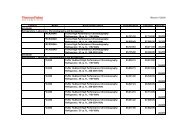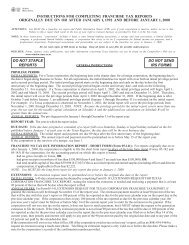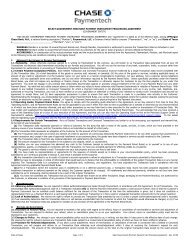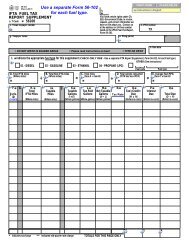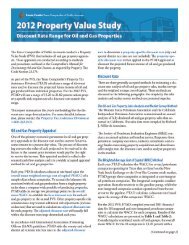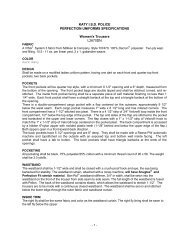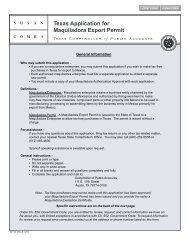Contracts Management Guide - Texas Comptroller of Public Accounts
Contracts Management Guide - Texas Comptroller of Public Accounts
Contracts Management Guide - Texas Comptroller of Public Accounts
You also want an ePaper? Increase the reach of your titles
YUMPU automatically turns print PDFs into web optimized ePapers that Google loves.
Performance Based Specifications vs. Design Specifications<br />
Performance based specifications focus on outcomes or results rather than process, and the required goods and<br />
services rather than how the goods and services are produced. Conversely, design specifications outline exactly how<br />
the contractor must perform the service or how the product is made. Performance based specifications allow<br />
respondents to bring their own expertise, creativity and resources to the bid process without restricting them to<br />
predetermined methods or detailed processes. This allows the respondents to provide the product or service at less<br />
cost and shifts some <strong>of</strong> the risk to the contractors. For example, if a state agency utilizes a design specification for a<br />
unit <strong>of</strong> laboratory equipment, and the equipment does not work correctly, then the results may be the fault <strong>of</strong> the<br />
specification. However, if the agency wrote a performance based specification, the unit must operate properly in order<br />
to meet the performance standards.<br />
For example, consider the purchase <strong>of</strong> media and advertising services:<br />
Performance Based Specification: Contractor shall provide media services for <strong>Texas</strong> Tourism which<br />
shall increase the tourist dollars by a minimum <strong>of</strong> three (3) percent in the next fiscal year. Visits by out <strong>of</strong><br />
state tourists shall increase a minimum <strong>of</strong> ten (10) percent. These figures will be measured as reported by<br />
the <strong>Texas</strong> Chamber <strong>of</strong> Commerce.<br />
Design Specifications: Contractor shall conduct at least seven (7) media campaigns for <strong>Texas</strong> Tourism<br />
during the fiscal year. Three (3) <strong>of</strong> these campaigns must be directed to out <strong>of</strong> state tourists.<br />
Mixed Specifications: Contractor shall provide media services for <strong>Texas</strong> Tourism which shall include a<br />
minimum <strong>of</strong> seven (7) media campaigns during the fiscal year. Media services shall provide for a minimum<br />
increase <strong>of</strong> three (3) percent in the next fiscal year as measured and reported by the <strong>Texas</strong> Chamber <strong>of</strong><br />
Commerce.<br />
As you can see, the performance based specification focuses on results, whereas the design specification focuses on<br />
resources. With design specifications, the contractor may provide all seven (7) campaigns, but the desired result <strong>of</strong><br />
increased tourist dollars and visits may or may not occur.<br />
As with all performance measures, agencies must ensure that performance specifications are reasonable and<br />
measurable. Note that the specification clearly outlines how the results will be measured. While performance based<br />
contracts are sometime preferable, when using this type <strong>of</strong> specification the planning, expertise and contract<br />
management may be different than design specifications.<br />
Design specifications are appropriate for simple purchases <strong>of</strong> goods such as paper, pens, furniture, and services such as<br />
temporary staff. Usually these purchases are accomplished by defining specific quantities and specifications for the<br />
goods or services, price per unit, as well as requirements for the time, place and manner for delivery and acceptance.<br />
Incentives: Many agencies now include incentives in their contract language. Incentives are used for outstanding<br />
performance which exceeds the goals contained in the contract. For example, if state tourism dollars increased by five<br />
(5) percent, the contract language sets forth a pre-established monetary incentive for increases above the required three<br />
(3) percent.<br />
Performance based specifications are fashioned so that respondents are allowed maximum flexibility when satisfying<br />
the requirements <strong>of</strong> a solicitation whereas, design specifications limit flexibility. It is not always beneficial to use<br />
performance based specifications. Examples <strong>of</strong> when to use performance or design specifications are provided below:<br />
• New installation, entire system provided by one vendor. A performance based specification should be<br />
used as it will allow the most economical solution to be applied since it is an entirely new system.<br />
• New installation, system provided by various suppliers. In this case, the agency may need to use a design<br />
specification to ensure that all <strong>of</strong> the characteristics <strong>of</strong> the system will work together. For example, a project to<br />
bid out the HVAC controls, chillers, fire alarms, etc. will all need to work together.<br />
28





